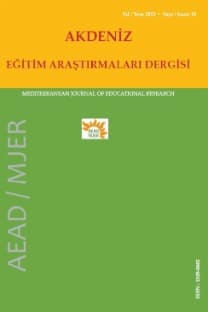Özel ve Devlet Üniversitelerinde Yapı Eğitiminin Kıyaslanması Üzerine Bir Araştırma
Üniversite düzeyindeki meslek eğitimleri içerisinde mimarlık eğitimi, meslek pratiğine bağlı olarak diğer meslek eğitimlerinden farklılık göstermektedir. Uzun ve zorlu bir süreç olan mimarlık eğitimi içerisinde ise teknik bilgi ve uygulama bakımından yoğun bir içeriğe sahip olan yapı dersleri ayrı bir öneme sahiptir. Mimarlık meslek pratiği açısından temel teşkil eden yapı derslerinin öğrenciler tarafından algılanması için teorik anlatımın yanı sıra genellikle iki boyutlu çizimler ve maketler araç kılınarak, dersler hoca-öğrenci arasında birebir eğitim şeklinde yürütülmektedir. Ağır ve yorucu bir süreç olan yapı eğitiminde, devlet üniversiteleri ile özel okullar arasında farklılıklar olabilmektedir. Çalışmada yapı dersleri içerik ve yöntem olarak benzer şekillerde yürütülen bir devlet üniversitesi ve bir özel üniversite ele alınmıştır. Her iki üniversitedeki yapı derslerinin konu içeriklerinin öğrenciler tarafından algılanması ve anlaşılmasındaki farklılıklar tarama yöntemiyle incelenmiştir. Bu inceleme yapılırken, yapı derslerinin mevcut teorik ve pratik uygulamalarının öğrencinin anlamasındaki etkileri ve öğrencinin dersi daha kolay anlaşılabilmesinde hangi ifade tekniklerinin daha etkili olduğu sorgulanmıştır. Çalışma ile devlet ve özel üniversitelerde, yapı eğitiminde temel farklılıklar ortaya konmaya çalışılmış ve eğitim kalitesini artırmaya yönelik öneriler geliştirilmiştir. Ayrıca yapı eğitiminde, konuların anlaşılabilirlik durumları ve anlamayı kolaylaştıracak araçların hangileri olduğu da istatistiksel çalışmalar sonucu ulaşılan bulgularla ifade edilmeye çalışılmıştır.
A Comparative Analysis of Construction Education in Private and State Universities
Architectural education in vocational courses at university level differs from other vocational courses by its professional practices. In architectural education, which is a long and difficult process, the construction courses which have an intensive content in terms of technical and practical knowledge are especially important. In addition to the theoretical lectures, the two-dimensional drawings and models are used as tools in order for the students to grasp the construction courses that constitute the basis of architectural practices. State and private universities may differ in their construction education, which is an intense and exhausting process. This study focuses on a state university and a private university, which conduct their construction classes in similar ways regarding content and methodology. The differences between students in their perception and understanding of the subject content of the construction courses at these two universities were examined by the application of survey methodology. The present study further attempted to find out which of the theoretical and practical applications of the construction courses had an effect on the students’ understanding, and which instructional techniques were more effective for learners’ understanding of the course. The basic differences in state and private universities regarding their construction education were presented, and suggestions for increasing the quality of education were offered. Furthermore, in construction education, the comprehensibility of the courses and the tools used to ensure the best understanding of the content were discussed on the basis of the findings revealed through statistical analyses.
___
- Ateş, S., (2008). Mekanik Konularındaki Kavramları Anlama Düzeyi Ve Problem Çözme Becerilerine
Cinsiyetin Etkisi, Eğitim Ve Bilim, 33(148) S:3-12
- Bunnell, W., A., (2017). Multimedia Techniques for Construction Education and Training, Master tezi,
Purdue University, West Lafayette, Indiana
- Özay E., Ocak İ., Ocak G., (2003). Genel Biyoloji Uygulamalarında Akademik Başarı Ve Kalıcılığa
Cinsiyetin Etkisi, Pamukkale Üniversitesi Eğitim Fakültesi Dergisi, (2) Sayı:14 63
- Parlak Biçer, Z., Ö., (2013). Is Gender Important on Understanding Construction Course in Architectural
Education, Procedia- Social and Behavioral Sciences 106, 1636 – 1647 2013
- Parlak Biçer, Z., Ö., (2010). “Öğrenci Cinsiyetinin Dersi Anlama Ve Algılamadaki Önemini Belirleme
Açısından Uygulamaya Yönelik Proje; Model Uygulama Alanı: Erciyes Üniversitesi Mimarlık
Fakültesi Birinci Sınıf Konstrüksiyon Bilgisi I Dersi Kapsamında Öğrenci Cinsiyetin Konu Üzerinde
Etkisinin Ölçülmesi”, Erciyes Üniversitesi Bilimsel Araştırma Projesi, Proje No: B-1068, Kayseri
- Topkaya, E., Z., Çelik H., Kuzgun, Y. Ve Deryakulu, D., (2006). Eğitimde Bireysel Farklılıklar
Güncelleştirilmiş Geliştirilmiş 2. Baskı, Ankara: Nobel Yayın Dağıtım, 346 S. Isbn 975–591–610–
5”, Egitimde Kuram Ve Uygulama 2009, 5 (2):316-321 Journal Of Theory And Practice İn
Education Reviews / Tanıtmalar Issn: 1304-9496 Http: // Eku. Comu. Edu.Tr /İndex /5/2/
Eztopkaya_Hcelik.Pdf Çanakkale Onsekiz Mart Üniversitesi, Egitim Fakültesi.
